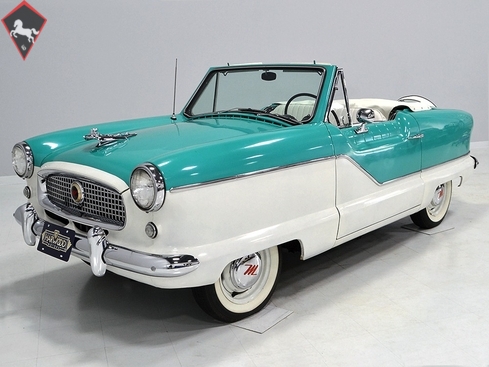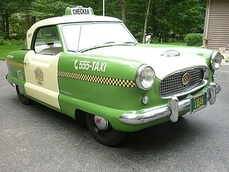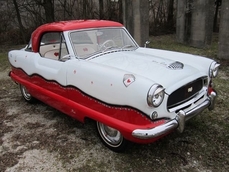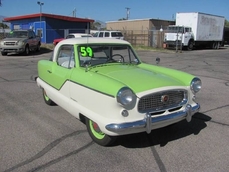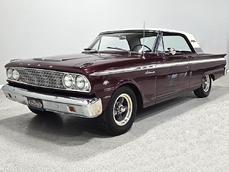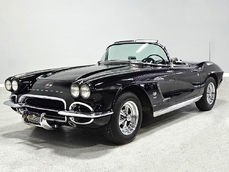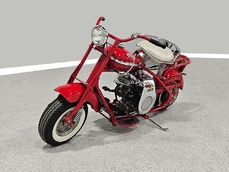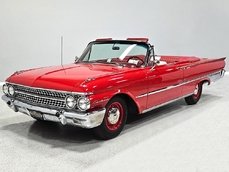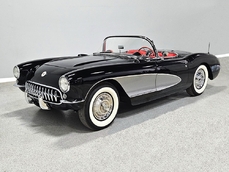Nash Metropolitan 91.4 cubic inch inline-4 1962
Allgemeine Beschreibung :
There were other small, economical cars before the Metropolitan, but few others were able to successfully join efficiency with style like the Met. A small car in a sea of land yachts, the Met still looked appropriate and today represents a great way to own a ‘50s icon without spending a fortune. Originally intended to be a second car for running errands or commuting to work, it packaged big car looks and feel in a compact footprint, which was entirely the point—it looked just like its bigger brothers in the Hudson and Nash showrooms. By 1960, however, mainstream automakers were taking notice and cars like the Ford Falcon and Dodge Dart were crowding the Metropolitan out of the market. Production ended in April 1961, but leftover models were sold until March 1962 under the Metropolitan name, as Hudson and Nash had merged to become American Motors and the Ramber became their mainstream product. Regardless, the diminutive little Met remains a beloved favorite of collectors and it’s a great way to have fun in the old car hobby without a big investment.
With jaunty and period-perfect Berkshire Green over Frost White paint, this can be nothing other than a product of the 1950s. The styling cleverly hides the car’s small proportions and the semi-skirted wheel openings were a Hudson and Nash styling trademark throughout the ‘50s, so it fits right in. This is a ’62 model, the final year of Metropolitan sales, and as such it has a simpler grille with only a stylized “M” badge to signify Metropolitan. The continental kit out back certainly helps it look substantial and adds space in the trunk area. This is an older restoration that was finished perhaps 15 or 20 years ago, but it is holding up quite well with nice paint that has a soft shine like period enamel. The cut lines and trim are right, the body fits together well, and we can find almost no evidence that this was ever a rusty car. It is not perfect, of course, but for a car that you’re going to drive and enjoy, it’s certainly going to get a lot of waves out on the road. It’s also got nice chrome and trim, including the Series III hood ornament with a touch of whimsy that’s ideal for the Met’s personality. If you want one to drive, this is a great choice.
The interior isn’t quite correct with its white vinyl pleats, but it’s durable and, more importantly, weatherproof. The pattern looks very right for the period and the workmanship is good enough to work with the rest of the car. The material cleans up easily and is virtually impervious to moisture and dirt, so it should look great for years to come. Black carpets match the black dashboard to keep it from being white overload and despite its size, there’s a modest back seat that’s ideal for kids. Technically, the Met was designed in England, so the single gauge pod with speedometer and fuel gauge shouldn’t be too surprising and the steering wheel with its integral turn signal lever should feel familiar to MG and Triumph owners as well. The 3-speed manual shifter looks a little odd but it works just fine and the neat headlight switch integrated with the ignition key keeps the dash looking tidy. An accessory AM radio still lives in the dash, although it is sadly inoperable. The convertible top fits reasonably well and has no serious marks or tears, and while the trunk opening is way up high, there’s plenty of room in there, even with a spare wheel and tire assembly.
Late production Mets received a bit of a horsepower bump thanks to increased compression, a reasonable 55 horsepower from the 91.4 cubic inch Austin A-40 inline-4. It’s not fast, so don’t expect to be blasting through traffic with the Metropolitan, but it’s torquey, energetic, and as the advertisements read, quite thrifty. The turquoise engine enamel isn’t quite authentic and it’s almost a match for the bodywork, and it’s a neat touch in the engine bay, which shows signs of use but no critical issues. All the original hardware is there, from the unique air filter assembly and carburetor to the big, round heater assembly right in the middle of the firewall. Period-correct touches include the plug wires and coil, and there’s a recent radiator up front so it stays cool. It starts easily and has a pleasing 4-cylinder sound, and if your expectations are modest, it’ll be a faithful companion for many years to come.
Handling is tidy and surprisingly nimble for a car with such small tires, but then again, that’s the benefit of less weight. The 3-speed manual transmission shifts cleanly and it’s geared to buzz along at 55 MPH or so without working too hard. The suspension puts a big car ride into this small package, so it’s comfortable just about anywhere and the brakes, while manual drums, don’t have much weight to contend with so they’re effective. Period road tests lauded the Metropolitan’s combination of durability and surprising comfort, and even today parts are readily available so they remain quite economical to own and maintain. Even the legendary Floyd Clymer said, "I can not praise the Metropolitan too highly. It is a fascinating little car to drive, its performance is far better than one would expect, and the ride is likewise more than expected." It’s finished with 5.20-13 Firestone tires on painted steel wheels, so it has a ‘50s look that’s just about right.
We have no illusions that this is a high-end car, but the cute personality, well-designed hardware, and appealing colors make this Metropolitan convertible a great way to get into the hobby for not a lot of cash. You’ll also find that Metropolitan fans are enthusiastic and knowledgeable and with their reputation for reliability, you’ll find that it’s a favorite to drive around town. With only 420 1962 Metropolitans sold before the end in 1962, it’s somewhat rare yet remains a familiar staple of the hobby. Best of all, it’s small so it’ll fit in your garage no matter what else you have in there. Call today!
http://www.harwoodmotors.com/vehicles/inventory_details.php?id=905
1962 Nash Metropolitan 91.4 cubic inch inline-4 is listed verkauft on ClassicDigest in Macedonia by for $17900.
Fakten der Auto
Karosserietyp : Auto Marke : Nash Modell : Metropolitan Ausführung : 91.4 cubic inch inline-4 Hubraum : 91.4 Modelljahr : 1962 Karosstyp : Convertible Lage : Ohio
Verkauft
Angaben Zum Verkäufer
Verkauft
People who viewed this Nash Metropolitan also viewed similar Nash listed at ClassicDigest
Other cars listed for sale by this dealer
über Nash
Identität und Besonderheiten von Nash Motors:Nash Motors, ein kleinerer amerikanischer Hersteller im Vergleich zu den dominierenden "Big Three" Automobilherstellern aus Detroit (General Motors, Ford und Chrysler), hatte eine einzigartige Identität und Geschichte, die sich auf verschiedene Weisen auszeichneten:
Innovative Merkmale: Nash war bekannt für seinen bahnbrechenden Ansatz zur Automobiltechnik und führte mehrere innovative Funktionen ein, die ihrer Zeit voraus waren.
Ungewöhnliches Design: Das Unternehmen bevorzugte oft unkonventionelle Designs, darunter aerodynamische Formen und markante Stilelemente.
Betonten Komfort: Nash legte Wert auf den Komfort der Passagiere und bot geräumige Innenräume sowie fortschrittliche Heiz- und Kühlsysteme.
Fortgeschrittene Sicherheitsmerkmale: Sie waren einer der ersten, die Sicherheitsfunktionen wie gepolsterte Armaturenbretter und Sicherheitsgurte in ihre Fahrzeuge integrierten.
Wirtschaftliche und Kraftstoffeffiziente Autos: Nash-Autos wurden für ihre Kraftstoffeffizienz und Zuverlässigkeit anerkannt und sprachen eine Zielgruppe an, die nach wirtschaftlicher Fortbewegung suchte.
Zehn bedeutende Nash-Modelle mit technischen Daten:
Nash Rambler (1950): Ein frühes Kompaktauto, der Rambler war aufgrund seiner kleinen Größe bekannt. Er hatte einen 173,3 Kubikzoll Motor mit 82 PS und erreichte etwa 25 mpg.
Nash Metropolitan (1953): Ein Kleinwagen mit einem 1,2-Liter-Motor, erzielte eine wirtschaftliche Leistung von 42 PS und bemerkenswerte Kraftstoffeffizienz von etwa 30-40 mpg.
Nash Ambassador (1949-1957): Ein Full-Size-Auto in verschiedenen Karosserievarianten, ausgestattet mit einem leistungsstarken 234 Kubikzoll, 112 PS Motor.
Nash Statesman (1949-1956): Ein weiteres Full-Size-Modell mit einem 184 Kubikzoll, 85 PS Motor und geräumigem Innenraumdesign.
Nash-Healey (1951-1954): Eine Sportwagen-Kooperation zwischen Nash und Healey, angetrieben von einem 252 Kubikzoll, 125 PS Motor und beeindruckender Leistung für damalige Verhältnisse.
Nash Airflyte (1949-1951): Diese Modelle hatten ein stromlinienförmiges Karosseriedesign und wurden von Motoren mit 172 bis 184 Kubikzoll angetrieben, die 82 bis 85 PS leisteten.
Nash Ambassador Custom (1956): Ausgestattet mit einem V8-Motor von entweder 250 oder 320 Kubikzoll, bot er eine Leistung im Bereich von 190-208 PS.
Nash 600 (1941-1949): Dieses Modell wurde vor dem Zweiten Weltkrieg eingeführt, hatte einen 172 Kubikzoll, 82 PS Motor und ein stromlinienförmiges Design für seine Ära.
Nash Lafayette (1934-1940): Diese Modelle hatten verschiedene Motorgrößen von 221 bis 234 Kubikzoll und produzierten 72 bis 95 PS.
Nash Advanced Eight (1933-1934): Mit einem Reihen-Achtzylinder-Motor mit 298 Kubikzoll, lieferte er etwa 125 PS, eine fortgeschrittene Funktion für damalige Zeiten.
Diese Nash-Modelle, jeweils mit ihren einzigartigen Merkmalen, trugen zum Ruf des Unternehmens für Innovation, Komfort und Kraftstoffeffizienz in der Automobilindustrie bei.
